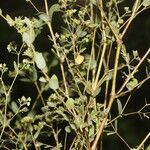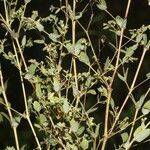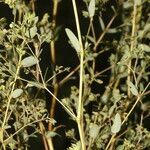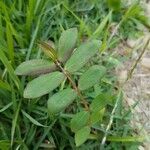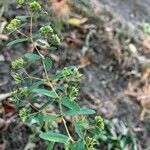Herbs, annual, 15-20 cm tall. Root fibrous, 0.8-1 mm. Stems many from base, ascending or suberect, rarely prostrate, ca. 1 mm thick, usually glabrous, rarely with a few hairs when young. Leaves opposite; stipules interpetiolar, truncate, 0.7-0.9 mm, shallowly lacerate; petiole 1.5-2 mm; leaf blade oblong-elliptic, 0.7-3 cm × 0.3-1.2 mm, thickly papery, base slightly oblique, asymmetric, subrounded, margin sparsely crenate, apex obtuse, adaxially with a few purple spots. Cyathia axillary and terminal, single or in small cymes, peduncle to 4 mm; involucre narrowly campanulate, ca. 0.8 × 0.4-0.5 mm, glabrous, marginal lobes 5, triangular; glands 4, yellow-green, rounded to transversely elliptic, appendages white or pale pink, wider than glands, to 0.7 × 0.5 mm, margin entire to slightly undulate. Male flowers 5-15, exserted; anthers red. Female flower pedicellate, exserted from involucre; ovary smooth, glabrous; styles free; stigma slightly 2-lobed. Capsule 3-angular-ovoid, 2-2.5 × ca. 2.5 mm, smooth, glabrous; fruiting pedicel ca. 2 mm. Seeds ovoid-tetragonal, ca. 1.1 × 0.8 mm, blackish, each side with 3 or 4 transverse furrows; caruncle absent. Fl. and fr. Jan-Apr.
Annual herb, semi-prostrate to erect, with branches to 40 cm. long, glabrous except for usually a few scattered hairs on branches, leaves and young growth.. Leaves lanceolate-ovate, to 2.5 × 1 cm. but usually much smaller, base obliquely rounded, apex rounded, margin minutely toothed; petiole 1 mm. long; stipules broadly triangular, to 0.75 mm. long, fimbriate.. Cyathia in terminal and axillary cymes, with peduncles elongating up to 10 mm. within each cyme; bracts enlarging from 1 mm. long to eventually resemble the leaves.. Cyathia ± 0.8 × 0.8 mm., with cup-shaped involucres; glands 4, green tinged red, minute, rounded, with minute creamy appendages; lobes acutely triangular, less than 0.2 mm. long.. Male flowers: bracteoles fimbriate; stamens 1 mm. long.. Female flower: ovary shortly pedicellate; styles 0.4 mm. long, suberect, bifid almost to the base.. Capsule exserted on a reflexed pedicel 1.25 mm. long, acutely 3-lobed, with base truncate, 1.5 × 1.5 mm., glabrous.. Seeds oblong-conical, 1 × 0.5 mm., reddish black, with 3 transverse ridges.. Fig. 77/4, 5, p. 416.
An erect, branched, rather graceful, annual herb, to 18 in. or more high
An introduced weed.
